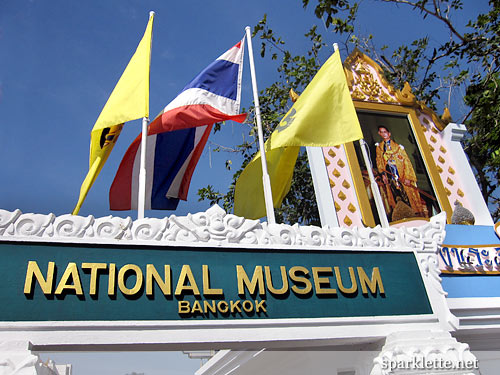A tour of the National Museum in Bangkok, which traces the early Thai civilizations in the region and the history of subsequent kingdoms, is like taking a stroll through the corridors of time. The short tour gives the visitor an overview of more than a millennium of history of the kingdom.
Our tour starts with the origin of early Thai civilizations in the first section in the National Museum. There's evidence of civilizations dating back to the early Stone Age from relics discovered in Lampang and Mae Hong Son in northern Thailand and Krabi to the south.
Civilizations existing around 3,600 BC were discovered in Ban Chiang, Udorn Thani in northeast Thailand as well as Kanchanaburi and Chonburi. There are conflicting theories as to where the early immigrants came from. However, there's sufficient evidence to show that there were civilizations in the area for more than 1,000 years.
The next section in the National Museum covers the 7th - 13th centuries when the Khmer empire, based in what is now Cambodia, was at the height of its power. The influence of Khmer culture covered the northeastern region of Thailand and extended all the way to Lopburi in central Thailand. Historical sites like Phanom Rung in Buriram and Phimai in Nakhon Ratchasima are testimony to this influence.
The 13th century saw the rise of the Sukhothai kingdom. The kingdom reached its pinnacle under the reign of King Ram Khamhaeng from 1279 - 1298 AD. Sukhothai not only grew in political and military stature, it was renowned for its art, architecture and culture. It was King Ram Khamhaeng who started the Thai alphabet.
The Ayutthaya section in the National Museum is the most substantial. Founded by King U-Thong in 1351, Ayutthaya was a city bounded by three rivers, the Chao Phraya, Lopburi and Pasak. It grew rapidly and soon eclipsed Sukhothai and the other kingdoms.
At the height of its influence, Ayutthaya was a major commercial center with three main palaces within a walled city with its network of roads and canals and protected by 16 forts. Trade with China, Portugal, the Netherlands and Japan flourished.
Ayutthaya was captured and sacked by Burma in 1569. The city was revived in 1584 by King Naresuan. Unfortunately it was overrun again and completely destroyed by the Burmese in 1767. Built up over four centuries, Ayutthaya with its 34 kings from five dynasties crashed to an abrupt and tragic end.
It was left to Phraya Taksin, son of a Chinese immigrant, who escaped the destruction of Ayutthaya to reestablish a new capital in Thonburi. In a series of campaigns he drove the Burmese out of Thailand and reunited the various kingdoms.
The grand finale in the tour of the National Museum covers the Chakri dynasty started by King Rama I in 1782 when he established Bangkok as the new capital to restore the former glory of Ayutthaya.
It was the dawn of a new era, Rattanakosin. After a massive Burmese onslaught was repelled, they were never a serious threat again. The prospect of a united Thailand with secure borders became a reality. Under the reign of the Chakri Kings, the next 200 years, saw the gradual emergence of a modern Thailand.
The National Museum in Bangkok captures more than a millennium of history of the early Thai civilizations, the rise and fall of the various kingdoms and dynasties to the present. It encapsulates the cultural ballast and very soul of the Thai nation.




No comments:
Post a Comment